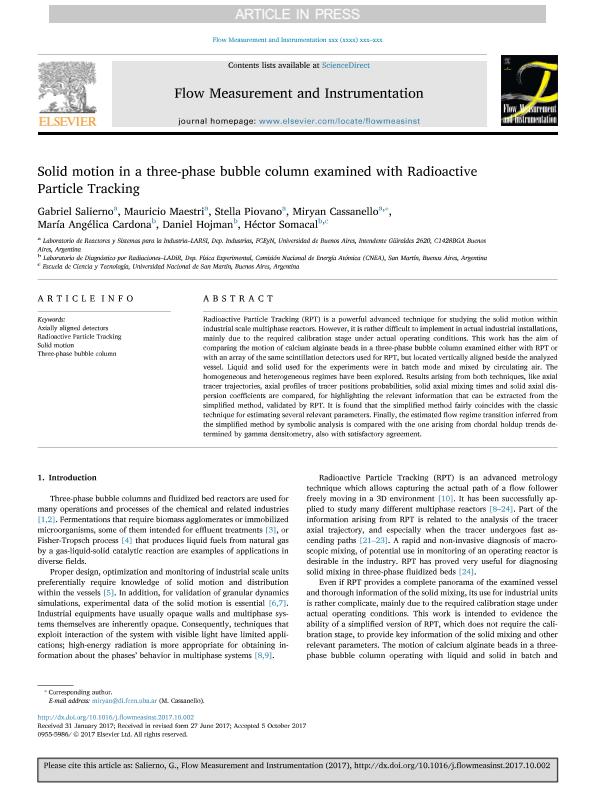Artículo
Solid motion in a three-phase bubble column examined with Radioactive Particle Tracking
Salierno, Gabriel Leonardo ; Maestri, Mauricio Leonardo
; Maestri, Mauricio Leonardo ; Piovano, Stella Maris; Cassanello Fernandez, Miryam Celeste
; Piovano, Stella Maris; Cassanello Fernandez, Miryam Celeste ; Cardona, Maria Angelica
; Cardona, Maria Angelica ; Hojman, Daniel Leonardo
; Hojman, Daniel Leonardo ; Somacal, Héctor Rubén
; Somacal, Héctor Rubén
 ; Maestri, Mauricio Leonardo
; Maestri, Mauricio Leonardo ; Piovano, Stella Maris; Cassanello Fernandez, Miryam Celeste
; Piovano, Stella Maris; Cassanello Fernandez, Miryam Celeste ; Cardona, Maria Angelica
; Cardona, Maria Angelica ; Hojman, Daniel Leonardo
; Hojman, Daniel Leonardo ; Somacal, Héctor Rubén
; Somacal, Héctor Rubén
Fecha de publicación:
08/2018
Editorial:
Elsevier
Revista:
Flow Measurement And Instrumentation
ISSN:
0955-5986
Idioma:
Inglés
Tipo de recurso:
Artículo publicado
Clasificación temática:
Resumen
Radioactive Particle Tracking (RPT) is a powerful advanced technique for studying the solid motion within industrial scale multiphase reactors. However, it is rather difficult to implement in actual industrial installations, mainly due to the required calibration stage under actual operating conditions. This work has the aim of comparing the motion of calcium alginate beads in a three-phase bubble column examined either with RPT or with an array of the same scintillation detectors used for RPT, but located vertically aligned beside the analyzed vessel. Liquid and solid used for the experiments were in batch mode and mixed by circulating air. The homogeneous and heterogeneous regimes have been explored. Results arising from both techniques, like axial tracer trajectories, axial profiles of tracer positions probabilities, solid axial mixing times and solid axial dispersion coefficients are compared, for highlighting the relevant information that can be extracted from the simplified method, validated by RPT. It is found that the simplified method fairly coincides with the classic technique for estimating several relevant parameters. Finally, the estimated flow regime transition inferred from the simplified method by symbolic analysis is compared with the one arising from chordal holdup trends determined by gamma densitometry, also with satisfactory agreement.
Archivos asociados
Licencia
Identificadores
Colecciones
Articulos(OCA CIUDAD UNIVERSITARIA)
Articulos de OFICINA DE COORDINACION ADMINISTRATIVA CIUDAD UNIVERSITARIA
Articulos de OFICINA DE COORDINACION ADMINISTRATIVA CIUDAD UNIVERSITARIA
Citación
Salierno, Gabriel Leonardo; Maestri, Mauricio Leonardo; Piovano, Stella Maris; Cassanello Fernandez, Miryam Celeste; Cardona, Maria Angelica; et al.; Solid motion in a three-phase bubble column examined with Radioactive Particle Tracking; Elsevier; Flow Measurement And Instrumentation; 62; 8-2018; 196-204
Compartir
Altmétricas



